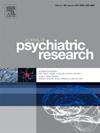首发精神分裂症与治疗难治性精神分裂症的精神病症状和童年创伤的网络结构
IF 3.7
2区 医学
Q1 PSYCHIATRY
引用次数: 0
摘要
目的探讨首发精神分裂症(FES)和难治性精神分裂症(TRS)患者的童年创伤(CT)网络结构与精神病症状的关系。具体来说,它试图阐明CT的不同维度如何影响FES和TRS的症状。方法对289例FES患者和50例TRS患者采用PANSS (Positive and Negative Syndrome Scale)量表和儿童创伤问卷进行评估。采用偏相关分析FES和TRS患者CT与症状之间的网络联系。进一步计算中间值、接近系数和社区检测来研究CT与精神病症状之间的相互作用。结果:(1)FES患者与TRS患者的症状-创伤网络存在差异;(2)基于网络分析,CT在TRS中形成紧密的相互联系,密切系数值更大,与FES相比,这影响了TRS的精神病症状。性侵犯在TRS网络中起着至关重要的作用,而情感忽视在FES中更为重要;(3)不同的社区结构表明FES和TRS患者的CT和症状通过不同的途径。具体而言,在FES症状-CT网络中,CT通过传统的症状模式影响症状,而在TRS中,该通路无法用传统的划分方法进行划分,涉及的方式较为复杂。结论FES和TRS患者的童年创伤经历与临床症状之间的联系途径不同,为早期创伤应激如何促进精神分裂症症状演变提供了有价值的见解。本文章由计算机程序翻译,如有差异,请以英文原文为准。
Network structure of psychotic symptoms and childhood trauma in first-episode versus treatment-resistant schizophrenia
Objective
The study aims to examine the network structures of childhood trauma (CT) and psychotic symptoms in patients with first-episode schizophrenia (FES) and treatment-resistant schizophrenia (TRS). Specifically, it seeks to elucidate how different dimensions of CT influence symptoms across FES and TRS.
Methods
289 patients with FES and 50 patients with TRS were assessed using Positive and Negative Syndrome Scale (PANSS) and Childhood Trauma Questionnaire. Partial correlation was used to elucidate the network connections between CT and symptoms in FES and TRS patients. Betweenness, closeness coefficient, and community detection were further calculated to investigate the interactions between CT and psychotic symptoms.
Results
The analysis revealed three key findings: (1) Symptom-trauma networks differ between FES and TRS patients; (2) Based on network analysis, CT in TRS forms tight interlinks, as evidenced by a larger value of closeness coefficient, which influences psychotic symptoms in TRS compared to FES. Sexual abuse plays a vital role in the TRS network while emotional neglect is more important in FES; and (3) The divergent community structures suggest distinct pathways through which CT and symptoms in FES and TRS patients. Specifically, in the FES symptom-CT network, CT influences the symptoms through traditional symptom patterns, while in TRS the pathway cannot be divided by traditional divisions and it involves a complex manner.
Conclusion
The findings suggest that the pathways linking childhood trauma experiences and clinical symptoms differ between FES and TRS patients, providing valuable insights into how early traumatic stress may contribute to symptom evolution in schizophrenia.
求助全文
通过发布文献求助,成功后即可免费获取论文全文。
去求助
来源期刊

Journal of psychiatric research
医学-精神病学
CiteScore
7.30
自引率
2.10%
发文量
622
审稿时长
130 days
期刊介绍:
Founded in 1961 to report on the latest work in psychiatry and cognate disciplines, the Journal of Psychiatric Research is dedicated to innovative and timely studies of four important areas of research:
(1) clinical studies of all disciplines relating to psychiatric illness, as well as normal human behaviour, including biochemical, physiological, genetic, environmental, social, psychological and epidemiological factors;
(2) basic studies pertaining to psychiatry in such fields as neuropsychopharmacology, neuroendocrinology, electrophysiology, genetics, experimental psychology and epidemiology;
(3) the growing application of clinical laboratory techniques in psychiatry, including imagery and spectroscopy of the brain, molecular biology and computer sciences;
 求助内容:
求助内容: 应助结果提醒方式:
应助结果提醒方式:


